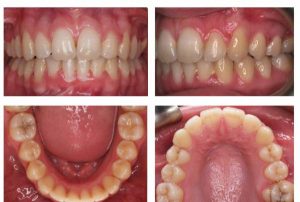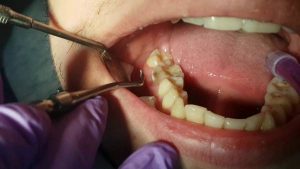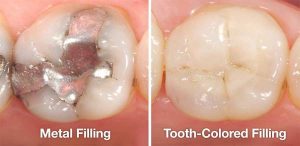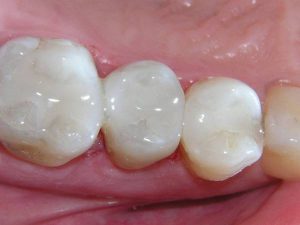Stages of denervation and Dental Filling
Caries are a bacterial dental disease that is one of the most common health disorders. Most people who suffer from tooth decay are in childhood or adolescence, but we see tooth decay at all ages.
Caries are one of the leading causes of tooth loss. Despite many advances such as regular dental examinations, fluoride, and health care in preventing caries, it still affects many people in the community.
Dental Filling:
The decay process is stopped by removing the decayed part of the tooth and filling it. In cases where the caries are extensive, the tooth is temporarily filled to show the tooth’s sensitivity to treatment. If no adverse symptoms are seen after a few days, the temporary restoration is removed, and the permanent restoration is replaced.
The type of material used for filling depends on the location and type of tooth. Large mill teeth have the highest performance and withstand a lot of pressure in chewing, so they need a more durable material than the front teeth. Front tooth fillings should be tooth-colored.

Steps of denervation and Dental Filling:
first stage
The entry of germs into the tooth pulp causes inflammation in the pulp, increasing the pulp volume. Because the dental pulp is located in a closed chamber, it causes a sharp increase in its internal pressure. This increase in pressure leads to pressure on the nerve endings of the tooth, and toothache begins. The increase in toothache at night is that when we lie down, the internal pressure of the tooth pulp increases even more. In ancient times, hot skewers were inserted into the caries site, and the toothache healed. Because perforation of the pulp roof and blood flow reduces the pressure inside the pulp and reduces pain, dentists now do the same with more advanced equipment.
The second step is the method of filling the teeth
After cleaning and removing the rot, we access the canals inside the roots. These ducts must be free of any soft tissue, germs, or canals. After this step, the root canals are ready to be filled.
The third step is the method of denervation and filling the teeth
The root canals are filled with a substance called gutta-percha. It is compatible with human tissue and contains materials that can be seen with radiography. It also can form and compress.
The fourth stage of denervation
Repair of the denervation crown must be done carefully because both the tooth tissue and the teeth become dry and brittle due to the denervation.

Different dental filling materials:
Amalgam
Amalgam is probably the oldest material used to fill teeth and is easily recognizable because of its silver color. Amalgam is a combination of several metals such as silver, mercury, and tin, and because the mercury in amalgam is toxic, it is not used sparingly in treatment.
However, amalgam is still one of the cheapest and most durable dental fillings, which is not very popular over time due to the darkening of the metal color. In addition, to use amalgam, the healthy part of the tooth must be shaved so that the material adheres well to the tooth. Also, because amalgam is made of metal, it can cause allergies to cold and heat.
composite
This composite looks like a natural tooth, and if used, the healthy part of the tooth does not need to be shaved to attach to it. Unlike metal, composite does not rust or discolor. Sticking these materials to the teeth makes them more durable and is a good option for repairing small caries.
But the disadvantage of composite is that it is not suitable for repairing large caries and the cost of filling teeth with composite is higher than amalgam. In addition, filling the teeth with composite takes longer, and the materials become more vulnerable to staining with tea and coffee.

ceramic
Ceramic or porcelain is a material that does not stick to teeth, unlike amalgam or composite. This material is prepared in a dental laboratory to cover caries well. The filling is not recognizable because it creates a natural tooth-like appearance.
But the main disadvantage of ceramics is that they are more expensive to fill than amalgam or composite teeth, and because they are bulky, more parts of healthy teeth need to be shaved than amalgam fillings.
Gold
As you can guess, gold is the most expensive material for filling teeth and is used only in cases where very high resistance is considered. Repairing gold in the laboratory is like repairing a ceramic and is recommended for people who have a filler resistant to discoloration and corrosion. Gold does not allow saliva, bacteria, and food particles of gold to penetrate the hole caused by decay.
Is the mercury in amalgam harmful?
Many people think that because of the mercury in amalgam, it is harmful to health and should not be used, but it must be said that numerous studies by dental scientists in the world have refuted this. This study showed that the mercury in amalgam is not harmful to the patient’s health. About ten years ago, the National Food and Drug Administration emphasized that the mercury in amalgam was not harmful to health and that its use was unrestricted. However, filling several teeth may cause mercury poisoning, and instead, they use amalgam, which is not very durable.
Why do some fillers break or empty?
Restored teeth are certainly not as durable as the first tooth, which is healthy and free of decay, and like closed dentures, they need more care. It also needs a closed cavity because the amalgam does not stick to the teeth. Observance of oral hygiene and instructions given by the dentist reduces the number of failures. Failure to follow health standards and care recommendations will cause caries in the remaining tooth tissue. In addition to the high pressures of the chewing system, the passage of a hard object such as a stone over the filler when eating weakens the walls of the cavity and the amount of tissue remaining, the width and depth of the cavity, its location, and the teeth involved are factors.
Cause of toothache after tooth filling:
While filling means eliminating tooth decay and cavities, sometimes the pain may not go away for a while, and this is quite common and may occur due to the following:

Sensitivity is the cause of pain after filling.
Some people are susceptible to anesthesia. After anesthesia, you can have a sensitive tooth, which usually disappears within a few days to two weeks after filing. If the pain goes away, contact your dentist.
Deep caries is one of the causes of pain after tooth filling
If you still have a toothache after filling, the tooth decay may be deeper and may require a nerve canal.
Allergic reactions cause pain after dental filling
Some people are allergic to amalgam fillers. While this is rare, allergic reactions include pain, skin inflammation, and itching. This often happens in people who are allergic to metals. The dentist can easily empty the filled material and replace it with new material.
Old fillings Causes of pain after dental filling
If you have pain after filling your teeth, you may have an old filling that needs to be replaced. Filling may take some time, but it is not always the case. Chewing or grinding your teeth can damage the filled teeth, and if the filled teeth are damaged enough, the food and bacteria under the old powder will cause decay and toothache and put you at greater risk—places for dental abscess.
How long do we have to wait for the pain to heal after filling?
If the pain after filling after the first two days is so severe that it disrupts your life, if the night pain feels a throbbing pain, and if after the first day or two you have to take medicine to control the pain and as soon as possible to see your dentist and discuss these issues with him.
But minor allergies are normal for a few days or even weeks after filling a tooth. You may feel uncomfortable drinking cold water, ice cream, and tea. But you should not always consume these foods in the next few weeks because your tolerance is a determining factor.
Home remedies for toothache after filling:
- If your teeth ache after filling, these simple home remedies will help you in the first few days.
- Try not to eat or drink anything too hot or too cold
- Try a brand of anti-allergy toothpaste
- Eat soft foods for the first few days.
- Use over-the-counter painkillers
- Avoid smoking.
- Use the other side of your mouth for a few days to chew.
- Clove oil

Filling children’s teeth:
Dental fillings can be done on both baby teeth and permanent teeth of children. For various reasons, such as tooth decay, tooth fractures, improper growth, and irregular teeth, children’s teeth may fill up after denervation or restoration of colored teeth.
Different methods of dental Filling:
Filling teeth can be done in three ways: filling teeth with a combination method (filling with white material), filling teeth with amalgam (silver color), or filling eugenol or zinc oxide. While amalgam is much stronger, composite materials are more beautiful.
Filling with glossy colored materials A way to fill children’s teeth:
These materials have seven different glossy colors that children will love. If your child is involved in choosing a filler color and asking him to choose his favorite color, it will reduce his fear. He should reduce his fear and enjoy the treatment process more.
Is filling teeth painful in children?
The child is first anesthetized and no longer feels anything. However, in the early stages of anesthesia, the child may feel cold water splashing on his teeth and feel pressure. In general, the whole process of filling teeth is almost fast and painless.










